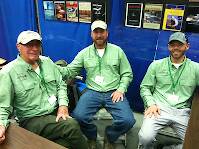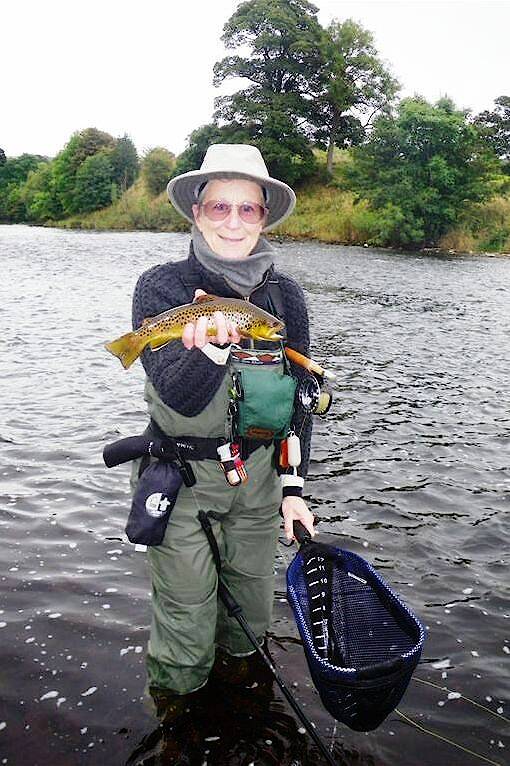
Salmonflies
Pteronarcys californica
The giant Salmonflies of the Western mountains are legendary for their proclivity to elicit consistent dry-fly action and ferocious strikes.
Featured on the forum

This one seems to lead to Couplet 35 of the Key to Genera of Perlodidae Nymphs and the genus Isoperla, but I'm skeptical that's correct based on the general look. I need to get it under the microscope to review several choices in the key, and it'll probably end up a different Perlodidae.

Troutnut is a project started in 2003 by salmonid ecologist Jason "Troutnut" Neuswanger to help anglers and
fly tyers unabashedly embrace the entomological side of the sport. Learn more about Troutnut or
support the project for an enhanced experience here.
CaseyP on Feb 4, 2018February 4th, 2018, 3:38 am EST
on my latest trip to a newly-opened fly shop in my neighborhood i was rewarded with a fine selection of Parachute Hoppers in several sizes and colors. these hard-to-find and worse-to-tie creations are my go-to fly for hopper times. in the face of many durable, high-floating, colorful hopper imitations, i still find that fish prefer the old pheasant tail legs and other "natural" components of a Parachute Hopper which slowly rides lower and lower as its dubbed body and other old-fashioned ingredients absorb more and more water.
when i fish in the west, i am amazed at the unlikely combinations of foam and plastic sold as hoppers.some of them float like pieces of packing peanuts. i think that fish that strike at them are used to luncheon bits dropped by drift boat anglers, and they will give any old thing a try, rather like a bass. drifting a Parachute Hopper down a seam or along the edge of a foam blanket gives me better results every time--although i've been with guides who refused to believe this.
how say the august sages of this board?
when i fish in the west, i am amazed at the unlikely combinations of foam and plastic sold as hoppers.some of them float like pieces of packing peanuts. i think that fish that strike at them are used to luncheon bits dropped by drift boat anglers, and they will give any old thing a try, rather like a bass. drifting a Parachute Hopper down a seam or along the edge of a foam blanket gives me better results every time--although i've been with guides who refused to believe this.
how say the august sages of this board?
"You can observe a lot by watching." Yogi Berra
Wbranch on Feb 5, 2018February 5th, 2018, 12:37 am EST
I have never caught a trout on a grasshopper fly. I have both styles, the traditional pheasant legs and turkey segment wings and the new sandwich style of various colors of foam strips and rubber legs. I put one on once in awhile but just don't have any confidence in them rising a trout.
Catskill fly fisher for fifty-five years.
RleeP on Feb 5, 2018February 5th, 2018, 1:26 am EST
Hi Casey... I can't offer any comparisons between parachute hoppers and any other style as I've never tied or fished a parachute hopper. Actually, I had virtually no hopper fishing experience at all until we moved to the Midwest in 2000 and I started fishing the Driftless spring creeks. Out there, the high density wild trout populations in small to medium size streams made hopper fishing (in August and September anyway..) a little bit like throwing pieces of hamburger to piranhas.
After monkeying-diddling around with a variety of hopper styles, I came to roughly the same conclusions you have. Foam hoppers bristling with rubber legs, etc. look appealing and float high, but move far fewer fish than hoppers tied from more traditional materials. I would agree that it is likely that a large part of this difference in effectiveness is the lower riding characteristics of the natural hoppers. I don't do the knotted pheasant tail leg thing; I have enough trouble tying my shoes as it is...
Anyway, eventually I settled on a sort of Letort Hopper variant with a rabbit fur body in the yellow to olive-tan range, a mottled turkey underwing and a natural deerhair wing/head pulled pretty low on both sides. Sometimes, I'd hang a thick barred rubber leg off each side to simulate the legs and sometimes I'll just pull a couple fibers of deerhair even farther down on each side. This seemed to work pretty well on the Driftless browns, far better than foam anyway.
Just in general, I'm an adherent of the "in the round"/generally suggestive school of tying. That is to say, when the fish are keyed on crayfish, I wouldn't take a bushel basket of any of the more precise crayfish patterns I've seen over a simple wooly bugger in the right colors.
I feel the same way about hopper patterns for the most part. In terms of precision sometimes, less can actually be more. Or something like that..:)
After monkeying-diddling around with a variety of hopper styles, I came to roughly the same conclusions you have. Foam hoppers bristling with rubber legs, etc. look appealing and float high, but move far fewer fish than hoppers tied from more traditional materials. I would agree that it is likely that a large part of this difference in effectiveness is the lower riding characteristics of the natural hoppers. I don't do the knotted pheasant tail leg thing; I have enough trouble tying my shoes as it is...
Anyway, eventually I settled on a sort of Letort Hopper variant with a rabbit fur body in the yellow to olive-tan range, a mottled turkey underwing and a natural deerhair wing/head pulled pretty low on both sides. Sometimes, I'd hang a thick barred rubber leg off each side to simulate the legs and sometimes I'll just pull a couple fibers of deerhair even farther down on each side. This seemed to work pretty well on the Driftless browns, far better than foam anyway.
Just in general, I'm an adherent of the "in the round"/generally suggestive school of tying. That is to say, when the fish are keyed on crayfish, I wouldn't take a bushel basket of any of the more precise crayfish patterns I've seen over a simple wooly bugger in the right colors.
I feel the same way about hopper patterns for the most part. In terms of precision sometimes, less can actually be more. Or something like that..:)
TNEAL on Feb 6, 2018February 6th, 2018, 1:39 am EST
Love hopper fishing. I used to use the pheasant legs; now am using rubber; they ride low and offer action on their own.I don't like the foam concoctions; either a dubbed body or poly body is more effective. I like the clipped deer hair head as in Dave's hopper but don't like the time involved, so I now use a technique with deer hair that provides a similar outline but takes about 15 seconds. PM me if you are interested in the pattern.
Jmd123 on Feb 6, 2018February 6th, 2018, 4:26 am EST
My favorite hopper is a modified Joe's Hopper:
2 red goose biots tied in splayed about 1/4 way down the bend of the hook (red legs);
abdomen of yellow chenille tied in with a free loop hanging over the bend of the hook (the end of the knobby abdomen of the hopper;
brown hackle palmered over the top of the chenille, then trimmed to 1/4 inch or less (makes for a nice spiky appearance);
mottled turkey wings tied in over grey or yellow elkhair (some grasshoppers have bright yellow underwings), to just past the bend of the hook;
mixed brown and grizzly hackle collar, then whip finish (I use black or brown thread).
It floats pretty well and stands up to trout teeth OK. In fact, even when they start getting shredded, they still work so long as you can get them to float!
Jonathon
P.S. My favorite for Michigan streams is a size 10, regular dry-fly hook (Mustad 94840 or equivalent). You can also tie this on a curved shank hook!
P.P.S. Tie it in all black with grey wings and you have a cricket! And, all-green for a katydid...
2 red goose biots tied in splayed about 1/4 way down the bend of the hook (red legs);
abdomen of yellow chenille tied in with a free loop hanging over the bend of the hook (the end of the knobby abdomen of the hopper;
brown hackle palmered over the top of the chenille, then trimmed to 1/4 inch or less (makes for a nice spiky appearance);
mottled turkey wings tied in over grey or yellow elkhair (some grasshoppers have bright yellow underwings), to just past the bend of the hook;
mixed brown and grizzly hackle collar, then whip finish (I use black or brown thread).
It floats pretty well and stands up to trout teeth OK. In fact, even when they start getting shredded, they still work so long as you can get them to float!
Jonathon
P.S. My favorite for Michigan streams is a size 10, regular dry-fly hook (Mustad 94840 or equivalent). You can also tie this on a curved shank hook!
P.P.S. Tie it in all black with grey wings and you have a cricket! And, all-green for a katydid...
No matter how big the one you just caught is, there's always a bigger one out there somewhere...
CaseyP on Feb 7, 2018February 7th, 2018, 3:28 am EST
interesting, all of it, guys!thanks!
WBranch, that is the perfect example of confidence in a fly. it was in the West that i learned about these, and seldom do i get any takes on my PA streams. too much woods, i think--hoppers live in pastures.
RLeeP, i, too do not tie my own parachute hoppers. the Letort style is as far as i'll go, and usually i just tie them in black for crickets. thanks for the ideas for "legs."
TNEAL, thanks for the pattern offer. i've had luck with a Thunder Creek-style head, but they don't come out very fat. look for a PM :)
JMD123, that's a nifty approach to a Joe's Hopper. thanks for a new use for the big packet of red goose quills lurking somewhere in the vast stash of materials that is called my office.
your replies are all just great--thanks for taking the time and confirming my suspicions that the best hopper anglers use something approaching The Real Deal.
now, to be truthful, i carry those foam obscenities when fishing out west, and had an opportunity to actually use them last summer. there were 4 or 5 different rubber patterns in my box, and no parachutes. i was fishing a little bitty headwater where the cutthroats can be very entertaining. conditions were typical August: low water and not a lot of action. after a bit i found a likely pool at a confluence. those fish rose to absolutely every pattern i had!
i think there were about a dozen fish in there, all 10-12 inches, and almost every single one made it to the net. if things slowed down, i changed rubber hoppers, and away we went again. poor hungry devils! i lost as many to mashed barbs as i landed, hence my estimate of the population: a new fly would attract any which had released long distance, i figured.
Cutthroats in little far-away streams are easy, so i'm still going to stick with parachutes for actual fishing, though.
WBranch, that is the perfect example of confidence in a fly. it was in the West that i learned about these, and seldom do i get any takes on my PA streams. too much woods, i think--hoppers live in pastures.
RLeeP, i, too do not tie my own parachute hoppers. the Letort style is as far as i'll go, and usually i just tie them in black for crickets. thanks for the ideas for "legs."
TNEAL, thanks for the pattern offer. i've had luck with a Thunder Creek-style head, but they don't come out very fat. look for a PM :)
JMD123, that's a nifty approach to a Joe's Hopper. thanks for a new use for the big packet of red goose quills lurking somewhere in the vast stash of materials that is called my office.
your replies are all just great--thanks for taking the time and confirming my suspicions that the best hopper anglers use something approaching The Real Deal.
now, to be truthful, i carry those foam obscenities when fishing out west, and had an opportunity to actually use them last summer. there were 4 or 5 different rubber patterns in my box, and no parachutes. i was fishing a little bitty headwater where the cutthroats can be very entertaining. conditions were typical August: low water and not a lot of action. after a bit i found a likely pool at a confluence. those fish rose to absolutely every pattern i had!
i think there were about a dozen fish in there, all 10-12 inches, and almost every single one made it to the net. if things slowed down, i changed rubber hoppers, and away we went again. poor hungry devils! i lost as many to mashed barbs as i landed, hence my estimate of the population: a new fly would attract any which had released long distance, i figured.
Cutthroats in little far-away streams are easy, so i'm still going to stick with parachutes for actual fishing, though.
"You can observe a lot by watching." Yogi Berra
Strmanglr on Mar 24, 2018March 24th, 2018, 1:39 am EDT
I'm into keeping synthetics out of my fly box. I've caught plenty on hopper flies. I like using them, nice and big, easy to see.
I've thought about tying foam flies because I presume they float really well to use with a dropper nymph.
I've thought about tying foam flies because I presume they float really well to use with a dropper nymph.
Quick Reply
Related Discussions
Topic
Replies
Last Reply
Re: Three Trouble Makers at the Midwest Fly Fishing Expo the past weekend

In the Photography Board by Oldredbarn

In the Photography Board by Oldredbarn
3
Mar 11, 2014
by TNEAL
by TNEAL





